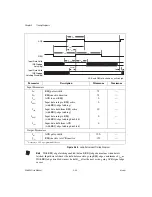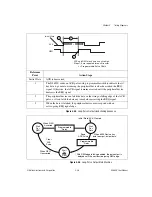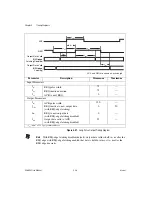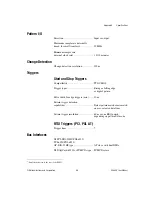
Chapter 3
Timing Diagrams
3-32
ni.com
Using the Long-Pulse Protocol
Figure 3-32.
Long-Pulse Input Handshaking Sequence
Reference
Point
Action Steps
Initial State
ACK is deasserted. The NI 653
X
waits for an active REQ to indicate that the
peripheral device is ready. The peripheral device may optionally drive the first
data at this time. The transfer cannot begin until the peripheral asserts REQ: the
peripheral may either pulse REQ or hold REQ high until the first ACK occurs.
If the peripheral pulses REQ, start the transfer on the NI 653
X
before the pulse
occurs to avoid missing the pulse.
1
The NI 653
X
asserts an ACK signal when it is ready to receive data, assuming
the peripheral device has deasserted the REQ signal. Otherwise, the ACK signal
remains asserted until the REQ signal deasserts.
2
To slow down the data transfer, you can insert a programmable delay before
deasserting the ACK signal. Unlike in the leading-edge protocol, the pulse width
is programmable.
3
After receiving the leading edge of the ACK pulse, the peripheral device can
strobe data into the NI 653
X
by asserting REQ.
4
The same programmable delay that controls the minimum ACK pulse width
further slows down the transfer by delaying next occurrence of the next ACK
pulse.
ACK
REQ
1
3
4
ACK and REQ are shown as active high.
Steps 1-4 are repeated for each transfer.
Initial State
2
Содержание NI 653 Series
Страница 1: ...PCI 6533...
















































